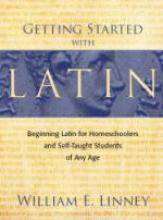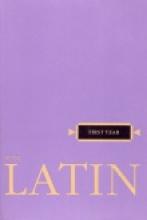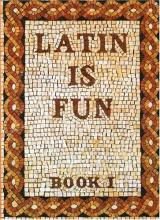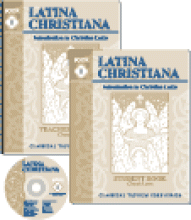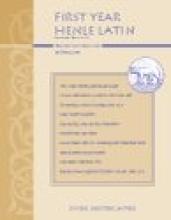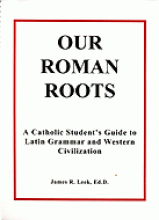Latin Programs
Getting Started with Latin
Henle Latin, First Year
Henle's First Year Latin is the book I studied as a homeschooled high schooler under the care of a great old Jesuit priest who left his position as a Latin and Greek professor at the all-boys Jesuit high school for a few hours each week to teach Latin to a small group of homeschoolers.
This is a very straightforward, but reasonably engaging text that focuses on a vocabulary list that will allow students to begin to read the works of Caesar in the Second Year. The real strength of this text is that it teaches the grammar in a way that provides students with the thinking and learning skills that are the hallmark of the study of Latin. (This is, of course, useful, even if the students don't go on to Henle II.) As a student, I complained a bit about the numerous stories involving soldiers and dead bodies, but I really enjoyed the course and was grateful for the jump-start in Latin before the more intense Latin studied at Thomas Aquinas College.
I like the way the text is broken up into two books - a Grammar book which lays out all the noun and verb endings, grammar rules and other basic stuff that will be useful through all four years of Latin; and the text itself which is much less intimidating when broken up in this fashion.
Overall, compared to other Latin texts I've used, this program seems particularly balanced in not being too overwhelming, but also not holding back on giving you enough of the big picture to make things clear. Also, the vocabulary is presented in an organized and logical fashion. To explain more fully, I quote from the preface: "It is rather common practice in Latin textbooks to set down a limited vocabulary for mastery, but to employ many more words in the reading material. First Year Latin limits its vocabulary for use largely to its vocabulary for mastery, and this vocabulary, incidentally, is drawn largely from the Caesar readings that will be taken in second year." I think this makes for a more useful, user-friendly text, particularly for families who are new to Latin.
Despite the emphasis on Caesar, this is a Catholic text and offers quite a bit of exercises and vocabulary relating to the faith. It would still be beneficial, however, to supplement the text with Latin hymns (from sources such as Lingua Angelica and The Adoremus Hymnal) and prayers.
Laura Berquist has written a syllabus/study guide for the Henle Latin which can be purchased from Emmanuel Books. Seton Home Study offers a Henle Latin course which includes lesson plans and telephone assistance from a Latin teacher. There is also a support-group e-mail list for those studying Henle Latin.
Latin is Fun, Book 1
I've been teaching Latin to two small classes in our weekly homeschool co-op for the past year using Latin is Fun as the primary text. The younger students were 9-11 yrs. old and the older students were ages 12-14. The text is a large workbook with a lot of cartoon-like illustrations and dialogue boxes to make the text engaging and intended to help students connect a Latin word directly with an idea rather than to the English word. Since this is a "classical" program and we wanted the children to learn "ecclestiastical" or "Church" Latin, we simply replaced the pronunciation guide in the front of the book and supplemented the program with Latin hymns and prayers.
We really enjoyed the Latin class and the students have become very enthusiastic about it, and I'm sure this is partly due to the format of the book. It really helped them connect Latin with real life today, made it fun and engaging, and gave them a really good start in Latin. They were forced to use what they learned in grammar very precisely and keep lots of rules, endings and vocabulary in their heads in order to successfully complete the assignment.
Having said this, there were a number of drawbacks to the book that might especially be frustrating to a homeschool family with no prior Latin experience. First, each chapter introduced a very large amount of vocabulary, some of which were hard to find when they came up in later usage. It would have been nice to include straight-forward vocabulary lists at the beginning of each chapter which could be studied and memorized, but the problems went farther than this as some of the vocabulary that would pop up mid-chapter couldn't even be found in the glossary in the back. We did make up our own vocabulary lists and study cards which helped to sort this out, but still had a lot of frustrations in completing particular assignments. Second, in order to keep the student from being overwhelmed with all the declensions of nouns, the author only introduces a few cases to begin with and then later goes back and sorts out how it all fits together. My students, however, sensed the disorder and really wanted to see how all the cases line up together in order to have the bigger picture in their heads. So we used this book alongside the Henle Latin Grammar which was a great aid in sorting things out. Third, although there seems to be plenty of written work in each chapter, there isn't really a lot of simple translation work at each stage which would have helped reinforce each idea as it was being studied. To resolve this, I had the students write up sentences for each other to translate (which was challenging and also fun - particularly since "silly" sentences were smiled upon). I also supplemented with some pretty tough crossword and word search puzzles (which are very easy to create at http://www.puzzlemaker.com) .
The long and short of it is that we had a great year with Latin and the students benefitted greatly from the extra effort we put into making the book work better for us. I covered about one third of the book with my older students, but the younger students got a bit bogged down with the grammar. We only went through a few chapters of the text, but spent lots of time making vocabulary cards and memorizing endings in order to prepare them for more Latin in the future. One of the moms in our co-op also gave the younger students several weeks of diagramming, which they learned to love and which is an excellent aid to understanding Latin. I'm sure they're on the right track for studying more Latin in the future.
The book is probably best for students or parents who have either had some Latin background or have a good grasp of English grammar.
Latina Christiana: Book I
Basic Set includes Student Book, Teacher's Manual and an audio tape or CD Teacher's Manual, 138 pages, softcover
This text is intended to introduce grade-schoolers to the Latin language. It is useful in preparing for future Latin studies in high school (particularly helpful for studying Henle Latin), but also teaches children some basics of grammar and vocabulary that sharpen thinking skills and assist in understanding the English Language more thoroughly.
This first volume teaches verbs from the First and Second Conjugation as well as two irregular verbs (sum and possum) and nouns of the First and Second Declensions. Students memorize present and imperfect endings of the First and Second Declension Nouns. They also study adjectives of the First and Second Declension and some personal pronouns. Exercises include finding appropriate endings for nouns and adjectives (which have to match in number, gender and case). A number of simple Latin sayings and prayers are studied as well.
The Teacher's Manual is very easy to use, providing all of the supplemental material for each lesson on the same page as the student material. The complete student book is reproduced in a smaller size on each page (with correct answers in a nice blue typeface) surrounded by lesson instructions, oral recitation lists, information about the Latin Saying for each lesson, Grammar instructions, Word Study and an extensive derivative list. It also includes reproducible blank maps for the students to identify locations, "History Key and Notes", and a complete set of reproducible Quizzes and Tests with Answer Keys.
The text is intended to work with Famous Men of Rome (and includes optional history questions along the way), although we've substituted The Story of the Romans by H.A. Guerber without any difficulty. The back of the text includes two very nice full-page maps, a list of history questions, the Pater Noster (Our Father) and Table Blessing, 15 basic conversational Latin phrases and the music and words for Adeste Fideles (O Come All Ye Faithful), Dona Nobis Pacem and Christus Vincit.
The third edition offers substantial improvements from the first and second editions. Changes include the Latin word identified for each derivative in the student lessons and the teacher's manual being integrated with reproductions of the student text (much easier to use than the old version!).
We've been using the Latina Christiana series in our local Latin homeschool co-op for a number of years. My teenage students, most of whom did not start out with Latina Christiana, have lamented that they didn't have a chance to memorize the forms and vocabulary given in these books before they started Henle. My 6th grade daughter has almost finished Latina Christiana II (supplemented with Basic Language Principles with Latin Background by Ruth Wilson - which is excellent!). She and her four fellow classmates have become very enthusiastic about their Latin studies and are well-prepared to start Henle as a class next year. My 3rd grade son studied the vocabulary from Prima Latina last year and has completed the first half of Latina Christiana I with his class this year. This has been such a wonderful experience for this school-resistant boy. He's really developing an interest in languages and learning that are spreading to other areas of study. The grammar, vocabulary and spelling that he's picking up in Latin have been invaluable - and I think more meaningful than a typical grammar book would have been for him.
To be quite honest, all of my students complain about the audio CD. Maybe it's just their midwestern up bringing, but the accent and audio quality is a real distraction to them. Personally, I think it's a fairly minor point, especially since, as author Cheryl Lowe points out, the purpose here isn't to develop great Latin speakers, but to develop thinking skills and related cultural benefits.
Learning Latin with Grandpa Carmellus
Program consists of an audio tape, a reader and an activity book (approximately 30 pages each) This home produced conversational Latin program is designed for young children. Your pre-Latin students from Kindergarten up may enjoy getting a taste of the language, especially if their older siblings are studying Latin. The program consists of two softcover books (the binding leaves something to be desired) and an audio tape.
The reader contains the full text of the audio tape so that the child may read along with the tape (and probably absorb the lesson more fully in this manner). Grandma Maria (who is helping out Grandpa Carmelus in the American version) takes us back to Ancient Rome with the help of "Sprig", the magic kangaroo. Each lesson introduces some basic Latin words and gives some practice using them in a sentence or other conversational context (such as counting). Children will learn how to say Hello and Goodbye, count various items from one to ten in Latin, and some simple sentences involving places, animals and everyday activities.
The activity book includes some fun Latin practice involving matching words, unscrambling and finding missing letters. Both books include lots of clip-art type illustrations which can be colored in by your young student.
Catholic content is found throughout the program - particularly in the Saint stories and the use of Catholic names (such as Jacinta - my 6 year old of that name was particularly delighted!)
For more information including how to order this program, click here. Note: The price for the program, noted on the website, is $16 plus $9 shipping - Australian Dollars. According to the Universal Currency Converter, this is equivalent to $10.18 plus $5.73 shipping - American Dollars. So the total cost, including shipping from Australia is $15.90
Memoria Press' Henle Latin Guides
Second volume published in 2003.
Our Roman Roots
Ecclesiastical Pronunciation, 15 weeks of lessons
Our Roman Roots was designed to teach children Latin through the functional method. This means that the material to be learned is presented in relation to what is already known to the child. Vocabulary and grammar are taught as aids to reading. This is unlike the approach used by many programs which emphasize grammar through chant and vocabulary through memorization. For example in the first lesson the child is given a short quote in Latin (eg. "To the stars through difficulties.") followed by an English translation of the quote. The student is instructed to draw lines between those Latin and English words which he thinks are the same. Later he is given vocabulary (many with illustrations) which contain some of the words that were in the original quotes. These quotes are used later to encourage critical thinking. Through repeated exposure to phrases, and some comments from the author, grammar is gradually introduced. Each weekly unit also involves the memorization of a Latin song or chant such as "The Lamb of God" and "The Our Father". Review is built into this program which comes with an easy to follow cassette tape that uses ecclesiastical Latin. My only complaint about this program is that a few words are introduced and never defined. The author suggests students can do each lesson alone in 45 minutes. In our family the lessons took over an hour and the student often didn't grasp parts of the material. I now sit side by side and do the lesson along with my child with both of us finishing in about 30 minutes. Our family adheres to the Classical approach which encourages chants and memorization (the opposite of what is used in this program), however ORR is a most pleasant introduction to Latin. Our family uses "English From the Roots Up" in second and third grade, "Our Roman Roots" in fourth grade and "Latina Christiana" in fifth grade. The student and teacher need no previous knowledge of Latin to use this program. While there are only 15 weeks of lessons most families will not be able to tie up this much time every day doing Latin. We do Latin every other week in our house, with quick review during the off week.
Schola Latina
After several challenging years of teaching beginning Latin to my elementary-grade children, I have finally found exactly the book that I wish I had had available from the beginning. Not only is this book classical in orientation and Christian in content, but it is also very well-organized and easy to use. This program can be begun as early as third grade by a motivated student with excellent reading fluency and some grammar knowledge, but it will be beneficial for a beginning Latin student of any age.
Schola Latina offers some unique features that make it stand apart from other Latin programs that are available. First, the vocabulary is immediately useful and relevant to the student. In the Preface, the author states, "When a present-day American child learns French (or English, for that matter), she begins by learning the names of the objects around her in the house. But when she starts Latin, she begins by learning military terms she's expected to come across in Caesar four years down the line. ... It was my goal that every word in the vocabulary list could be used in simple, natural sentences as the students learned the rudiments of grammar." Another very motivating feature is the variety of puzzles designed to drill the reading, writing, and spelling of the vocabulary words. This unique, painless spelling emphasis has an immediate benefit in the spelling of English derivatives as well. A third feature is the conversational practice in each lesson. Not only will the student practice the infamous Latin mottoes and lovely biblical phrases, he will also learn to say "Merry Christmas!", and "My head aches!"
Each of the twenty-four lessons includes five teaching sections and five clearly-marked daily assignments. The teaching sections follow this pattern: a famous Latin saying, a practice conversation, new vocabulary words with a few questions that require critical thinking, Latin grammar with English grammar review and comparison, and a history summary keyed to Famous Men of Rome. The Famous Men book is not required to use this course, but it will be a very useful addition to extend the history lesson. The daily assignments vary from day to day and week to week, but they all are very easy to use and work to reinforce the new material while reviewing previous lessons. Activities include oral recitations, written work on derivatives and history, and puzzles and translation practice; each lesson concludes with a reminder for the student's parent to check their work. The student's text also includes a pronunciation guide, a glossary (both English-to-Latin and Latin-to-English), a listing of Latin numbers, and several songs in Latin.
A Teacher's Manual is also available and highly recommended. It includes the full text of the student's pages, with the correct answers included, as well as specific teaching notes. The teaching notes describe potential difficult areas, suggest additional practices, and remind the teacher about the chants and forms to drill.
Further information and sample pages are available at the author's website noted below. I'm very excited about this Latin course, and I'm looking forward to using the second book in the series next year!

